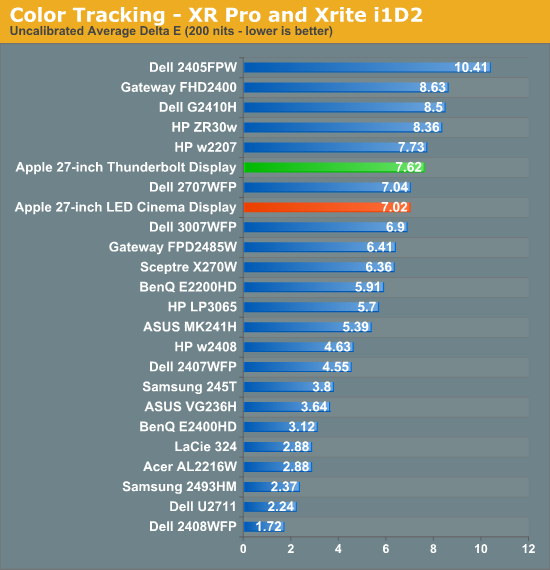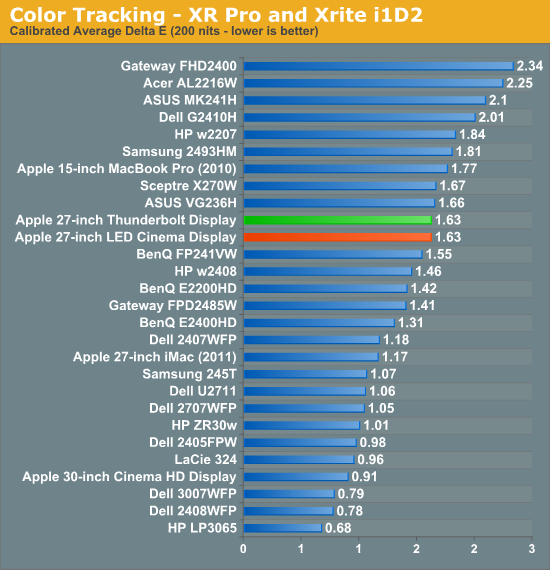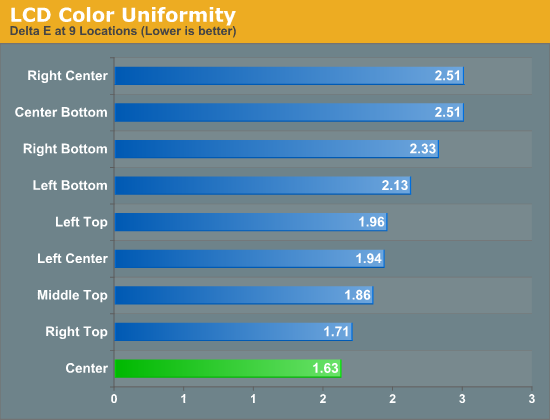The Apple Thunderbolt Display Review
by Anand Lal Shimpi on September 23, 2011 2:56 AM EST- Posted in
- Displays
- Mac
- Apple
- Thunderbolt
- Thunderbolt Display
Display Testing
With all of the extra connectivity there is to test with the Thunderbolt Display we can't forget the actual panel testing. Thankfully this part is pretty simple, the display characteristics are near identical to the 27-inch LED Cinema Display we reviewed last year.
Color Quality
We report two main quality metrics in our display reviews: color accuracy (Delta-E) and color gamut. Color gamut refers to the range of colors the display is able to represent with respect to some color space. In this case, our reference is the AdobeRGB 1998 color space, which is larger than the sRGB color space. So our percentages are reported with respect to this number, and larger is generally better.
Color accuracy (Delta E) refers to the display’s ability to display the correct color requested by the GPU and OS. The difference between the color represented by the display, and the color requested by the GPU is our Delta-E, and lower is better here. In practice, a Delta E under 1.0 is perfect - the chromatic sensitivity of the human eye is not great enough to distinguish a difference. Moving up, a Delta E of 2.0 or less is generally considered fit for use in a professional imaging environment - it isn’t perfect, but it’s hard to gauge the difference. Finally, Delta E of 4.0 and above is considered visible with the human eye. Of course, the big consideration here is frame of reference; unless you have another monitor or some print samples (color checker card) to compare your display with, you probably won’t notice. That is, until you print or view media on another monitor. Then the difference will no doubt be apparent.
As I mentioned in our earlier reviews, we’ve updated our display test bench. We’ve deprecated the Monaco Optix XR Pro colorimeter in favor of an Xrite i1D2 since there are no longer up-to-date drivers for modern platforms.
For these tests, we calibrate the display and try to obtain the best Delta-E we can get at 200 nits of brightness for normal use. We target 6500K and a gamma of 2.2, but sometimes the best performance lies at native temperature and another gamma, so we try to find what the absolute best performance could be. We also take an uncalibrated measurement to show performance out of the box using either the manufacturer supplied color profile, or a generic one with no LUT data. For all of these, dynamic contrast is disabled.

Uncalibrated performance remains fairly similar to last year's LED Cinema Display, however once calibrated the Thunderbolt Display is spot on with its predecessor:

As we mentioned earlier, a sub 2.0 delta E is good enough for professional use. Although not perfect the Thunderbolt Display falls within that range for sure.


We measured slightly lower color gamut on the Thunderbolt Display than the original LED Cinema Display, however the result was much closer to the 2011 27-inch iMac. I couldn't visibly tell any differences and Apple indicates that color gamut shouldn't have changed, so it's quite possible that the differences here are due to our colorimeter and not the panel.
Color Uniformity
Now for color consistency, we take our best calibration profile from the very center at 200 nits and test color accuracy at 9 different places around the LCD display in an evenly distributed grid. We’ve shown before that calibration is localized across the display, partly due to the brightness not being uniform, partly due to the discrete nature of the display itself.

The Thunderbolt Display was fairly uniform across its surface, something we noticed in reviewing the 27-inch LED Cinema Display last year. Uniformity is actually better on this panel than the one we reviewed last year, although in both cases I couldn't really tell any differences.
Peak brightness appears down slightly, but so are the black levels which result in a slightly better contrast ratio. Apple is also calibrating these things at the factory now so white points are now set at around 6300K vs. 7100K on the original 27-inch LED Cinema Display.










275 Comments
View All Comments
mcturkey - Friday, September 23, 2011 - link
I guess I really don't understand why they can't just make a non-integrated docking station. Use Thunderbolt to connect it if need be, but making it part of the display seems to just add a very unnecessary expense increase if you find yourself needing a new monitor or different/more/better ports in the future.Constructor - Friday, September 23, 2011 - link
As far as I'm aware there are already multiple external PCIe slot housings and other adapters on the way which will effectively serve that purpose.And all of them will be usable with any Mac or PC which has suitable PCIe drivers for the respective ports, so Thunderbolt can indeed provide the long-missing "universal dock".
The complication may be that these drivers should be able to survive hot plugging if you want to avoid having to reboot the machine every time you (dis)connect such an external box (or possibly risk a blue screen / kernel panic otherwise).
Apple just chose to make one specific bundle product; They're leaving all the other possibilities to third parties so far. Once such alternatives are on the market, it's simply your choice.
SameerRamesh - Friday, September 23, 2011 - link
My strong gut feeling suggests that apple will bring only USB 3.0 ports to all their next-gen Macs. Why?Intel's IVB chipsets have native USB 3.0 support. So apple needn't do any extra work there. Furthermore, not adopting an industry standard is a loss. Adding to that, they haven't gone against USB 3.0 now, have they?
Why only USB 3.0 in the next-gen Macs? That's Apple's style!
Constructor - Friday, September 23, 2011 - link
Current Intel chipsets don't have USB3 on chip, so it would take external USB3 controllers to add them to a Mac.The problem is that such external controllers consume precious PCIe 2 lanes which are comparatively scarce with the mobile Intel CPUs. I've not checked the data sheets, but there may simply not be enough PCIe 2 lanes with a mobile Intel CPU to supply both a full-speed-capable external USB3 controller and the Thunderbolt controller at the same time.
Given that choice, I'd say Thunderbolt is the far better option of the two (not least since you can connect USB3 externally through it, but not vice versa).
Desktop CPUs are less constrained, so the iMac and the Mac Pro could have both at the same time even with the current CPU generation (through PCIe plugin cards, if need be).
But I expect Apple to make the jump with the upcoming CPUs which simply provide them on chip with nothing to sacrifice for it.
JasperJanssen - Saturday, September 24, 2011 - link
Ivy Bridge generation Macs will obviously have USB3. Presumably enough of them so that there are no USB2 ports left, as Apple does not like mix and match. And when the Macs have USB3, the display will get it too.quiksilvr - Friday, September 23, 2011 - link
Can you use this Thunderbold Display on another Thunderbolt computer that isnt Mac?Anand Lal Shimpi - Friday, September 23, 2011 - link
Theoretically, yes. We won't know for sure until we see the PC implementations of Thunderbolt but according to Apple if a PC vendor were to integrate Thunderbolt and fully follow the spec the Thunderbolt Display would work.Take care,
Anand
the goat - Friday, September 23, 2011 - link
Somebody already solved this problem decades ago. It is called a laptop docking station. All those cables you are complaining about stay plugged into the docking station.Parhel - Friday, September 23, 2011 - link
That's what's confusing me about this too. Why is this better than, or even as good as, a docking station?With my docking station, I just have to put my laptop on it, and I'm connected to wired network, monitor, mouse and keyboard. I could add another monitor (2 dual link DVI ports), speakers, a printer, and I believe 4 USB devices to that.
I have one docking station at home, one at the office. The dock for home cost me under $100, and it's compatible with both my laptop and my wife's. This seems like a step down from that.
HMTK - Friday, September 23, 2011 - link
If you wan't a razor thin laptop like a MBA there's no room for a docking connector in the laptop. That's probably the main reasons why Apple makes this thing. For their customers it's good.Personally I prefer a docking station exactly for the reasons you stated. I would like to use a generic docking station that's not USB though because now docking stations can only be used with a limited number of machines and there's no compatibility between brands.
Laptop makers are being forced by the EU to make compatible power bricks. Why not do the same for docking stations? Or force them to make a single connector for data and power that's also compatible with a power supply only?